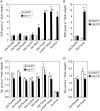A gamma-glutamyl transpeptidase-independent pathway of glutathione catabolism to glutamate via 5-oxoproline in Arabidopsis
- PMID: 18768907
- PMCID: PMC2577253
- DOI: 10.1104/pp.108.125716
A gamma-glutamyl transpeptidase-independent pathway of glutathione catabolism to glutamate via 5-oxoproline in Arabidopsis
Abstract
The degradation pathway of glutathione (GSH) in plants is not well understood. In mammals, GSH is predominantly metabolized through the gamma-glutamyl cycle, where GSH is degraded by the sequential reaction of gamma-glutamyl transpeptidase (GGT), gamma-glutamyl cyclotransferase, and 5-oxoprolinase to yield glutamate (Glu) and dipeptides that are subject to peptidase action. In this study, we examined if GSH is degraded through the same pathway in Arabidopsis (Arabidopsis thaliana) as occurs in mammals. In Arabidopsis, the oxoprolinase knockout mutants (oxp1-1 and oxp1-2) accumulate more 5-oxoproline (5OP) and less Glu than wild-type plants, suggesting substantial metabolite flux though 5OP and that 5OP is a major contributor to Glu steady-state levels. In the ggt1-1/ggt4-1/oxp1-1 triple mutant with no GGT activity in any organs except young siliques, the 5OP concentration in leaves was not different from that in oxp1-1, suggesting that GGTs are not major contributors to 5OP production in Arabidopsis. 5OP formation strongly tracked the level of GSH in Arabidopsis plants, suggesting that GSH is the precursor of 5OP in a GGT-independent reaction. Kinetics analysis suggests that gamma-glutamyl cyclotransferase is the major source of GSH degradation and 5OP formation in Arabidopsis. This discovery led us to propose a new pathway for GSH turnover in plants where GSH is converted to 5OP and then to Glu by the combined action of gamma-glutamyl cyclotransferase and 5-oxoprolinase in the cytoplasm.
Figures





Similar articles
-
A γ-glutamyl cyclotransferase protects Arabidopsis plants from heavy metal toxicity by recycling glutamate to maintain glutathione homeostasis.Plant Cell. 2013 Nov;25(11):4580-95. doi: 10.1105/tpc.113.111815. Epub 2013 Nov 8. Plant Cell. 2013. PMID: 24214398 Free PMC article.
-
Glutathione conjugates in the vacuole are degraded by gamma-glutamyl transpeptidase GGT3 in Arabidopsis.Plant J. 2007 Mar;49(5):878-88. doi: 10.1111/j.1365-313X.2006.03005.x. Plant J. 2007. PMID: 17316176
-
Arabidopsis thaliana Oxoprolinase 1 (AtOXP1) maintains glutamate homeostasis, promotes arsenite and mercury tolerance, and reduces accumulation in plants.Plant J. 2025 Apr;122(2):e70154. doi: 10.1111/tpj.70154. Plant J. 2025. PMID: 40287956
-
Degradation of glutathione and glutathione conjugates in plants.J Exp Bot. 2023 Jun 6;74(11):3313-3327. doi: 10.1093/jxb/erad018. J Exp Bot. 2023. PMID: 36651789 Review.
-
New aspects of glutathione metabolism and translocation in mammals.Ciba Found Symp. 1979;(72):135-61. doi: 10.1002/9780470720554.ch9. Ciba Found Symp. 1979. PMID: 45011 Review.
Cited by
-
Growth platform-dependent and -independent phenotypic and metabolic responses of Arabidopsis and its halophytic relative, Eutrema salsugineum, to salt stress.Plant Physiol. 2013 Jul;162(3):1583-98. doi: 10.1104/pp.113.217844. Epub 2013 Jun 4. Plant Physiol. 2013. PMID: 23735509 Free PMC article.
-
Metabolomic and Physiological Changes in Fagus sylvatica Seedlings Infected with Phytophthora plurivora and the A1 and A2 Mating Types of P. ×cambivora.J Fungi (Basel). 2022 Mar 14;8(3):298. doi: 10.3390/jof8030298. J Fungi (Basel). 2022. PMID: 35330301 Free PMC article.
-
Cytosolic action of phytochelatin synthase.Plant Physiol. 2010 May;153(1):159-69. doi: 10.1104/pp.109.149922. Epub 2010 Mar 19. Plant Physiol. 2010. PMID: 20304971 Free PMC article.
-
Changes in primary and secondary metabolite levels in response to gene targeting-mediated site-directed mutagenesis of the anthranilate synthase gene in rice.Metabolites. 2012 Dec 18;2(4):1123-38. doi: 10.3390/metabo2041123. Metabolites. 2012. PMID: 24957777 Free PMC article.
-
Gamma-glutamyl cycle in plants: a bridge connecting the environment to the plant cell?Front Plant Sci. 2015 Apr 16;6:252. doi: 10.3389/fpls.2015.00252. eCollection 2015. Front Plant Sci. 2015. PMID: 25932030 Free PMC article. No abstract available.
References
-
- Alonso JM, Stepanova AN, Leisse TJ, Kim CJ, Chen H, Shinn P, Stevenson DK, Zimmerman J, Barajas P, Cheuk R, et al (2003) Genome-wide insertional mutagenesis of Arabidopsis thaliana. Science 301 653–657 - PubMed
-
- An YQ, McDowell JM, Huang SR, McKinney EC, Chambliss S, Meagher RB (1996) Strong, constitutive expression of the Arabidopsis ACT2/ACT8 actin subclass in vegetative tissues. Plant J 10 107–121 - PubMed
-
- Bradford MM (1976) A rapid and sensitive method for the quantitation of microgram quantities of protein utilizing the principle of protein-dye binding. Anal Biochem 72 248–254 - PubMed
-
- Beck A, Lendzian K, Oven M, Christmann A, Grill E (2003) Phytochelatin synthase catalyzes key step in turnover of glutathione conjugates. Phytochemistry 62 423–431 - PubMed
-
- Blum R, Beck A, Korte A, Stenge A, Letzel T, Lendzian K, Grill E (2007) Function of phytochelatin synthase in catabolism of glutathione-conjugates. Plant J 49 740–749 - PubMed
Publication types
MeSH terms
Substances
LinkOut - more resources
Full Text Sources
Molecular Biology Databases
Miscellaneous

